
As many of my readers noticed, I didn't publish any of my own blogs in January and February. As it turned out, I suffered from a peculiar form of seasonal affective disorder (SAD), what I would call SMIAD: Subject Matter Ineligible Affective Disorder. The unrelenting rains here in San Francisco, a similar torrent of Section 101 rejections from the USPTO, and an uptick in the rate of court decisions invalidating patents, converged to put me in a dour and de-inspired mood. With the return of the sun and some interesting decisions from the Federal Circuit, it’s time to get back to tracking AliceStorm.
First, an update on the overall AliceStorm numbers, through the end of February, 2017:
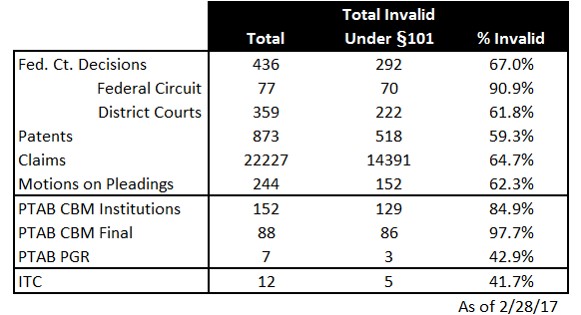
Compared to the December numbers, the changes are mixed. The Federal Circuit ineligibility rate increased 1.9% to 90.9%, while the district court rate declined 1.2% to 61.8%. There’s been a 1% drop in the overall percentage of patents invalidated as well, down to 59.3%.
The success rate on motions on the pleadings (including both motions to dismiss and motions for judgment on the pleadings) is down 0.6% to 62.3%.
For PTAB, I’ve added a new row for Post Grant Reviews based on Section 101. The success rate here is 42.9%. For CBM reviews, the numbers for PTAB are steady, with less than a 1% change since December.
Breaking the court numbers down into monthly data, we have the following trend information:
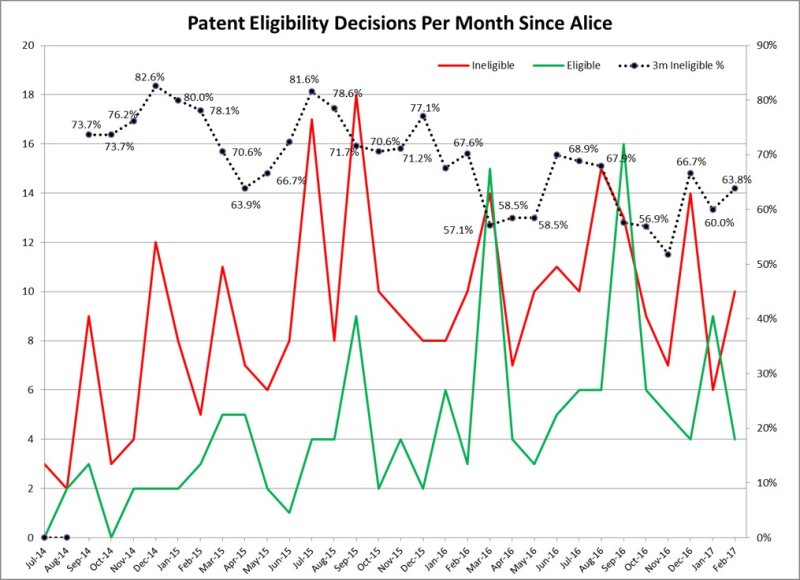
The red line shows the number of federal court (district and Federal Circuit) decisions invalidating patents under Section 101; the green line is the number of eligible decisions. We can see a slight trend that the numbers of ineligible decisions are declining and the eligible ones are increasing.
This is confirmed by the dashed black line, which is the three-month moving average ineligibility rate, in terms of percent (i.e., total number of ineligible decisions in the current month and prior two, divided by total number of decisions). That trend line has been slowly but steadily falling since June, 2015. This may be due to a couple of interrelated reasons. First, the early decisions were on patents asserted in earlier filed litigations, and these patents may have been weaker to begin with, selected by patentees before the risk of Section 101 ineligibility became clear. Second, early on the district courts were still finding their way around Section 101 issues, with many courts noting the lack of clarity in the law, in part due at that time to only a single—and narrowly cast—example of eligible subject from the Federal Circuit, DDR. Over time, patentees may have become more selective in which patents they asserted, while the Federal Circuit has provided more examples of eligible subject matter. This gave the district courts better guidance to work with, and less suspect patents to rule on. This is not to say that the common law approach will work out just fine in patent eligibility, since the Alice test itself, and the doctrine being fashioned by the Federal Circuit to implement it, can never be entirely consistent or rational.
In terms of motion success, we find the following:
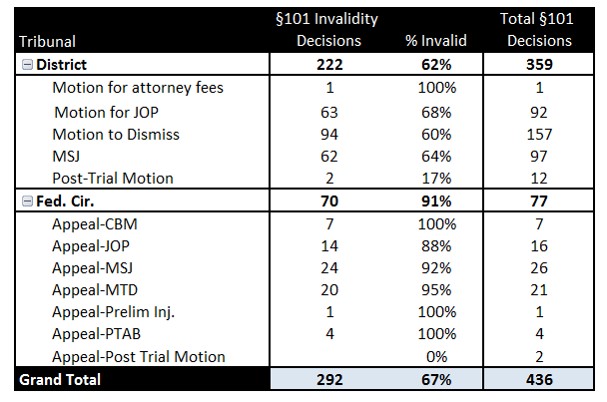
Motions for judgment on the pleadings for patent eligibility are on average significantly more successful than motions to dismiss, or even motions for summary judgment. At the Federal Circuit, all appeals from PTAB, both for CBM and ex parte, have been denied and the patents all invalidated. It’s not clear that the Federal Circuit is being deferential to PTAB; rather this could be a result of how these decisions come to the court. CBM appeals thus far have only been of those reviews that reach a final written decision of ineligibility, and likewise the ex parte appeals are only of final rejections. Without examples of a CBM final written decision finding eligible subject matter, we cannot tell whether the Federal Circuit is being deferential or simply confirming that they agree with PTAB’s decisions (being deferential would have the court affirming PTAB outcomes consistently, for both eligible and ineligible subject matter).
Let’s break down how the Federal Circuit decisions are rendered:

What stands out here is that of the 70 ineligibility decisions, 40 (57%) are Rule 36 per curiam affirmances. Some commentators have argued Rule 36 affirmances in Section 101 are improper, and indeed harmful to patentees. From a purely pragmatic point of view, as a patent prosecutor, I much prefer Rule 36 affirmances. These decisions are non-precedential and should not be relied upon by patent examiners in their Section 101 rejections, according to recent USPTO guidance. If the Federal Circuit had issued these decisions with written opinions, even if only half were made precedential, that would have almost doubled the number of precedential ineligibility decisions (21). These precedential decisions would be included in the USPTO's summary chart of cases the examiners can use, and likely included in further examples of ineligible subject matter. In short, would make it easier for examiners to reject pending applications under Section 101. As the data shows below, the examiners need no more help.
Let’s look at the Federal Circuit scorecard:
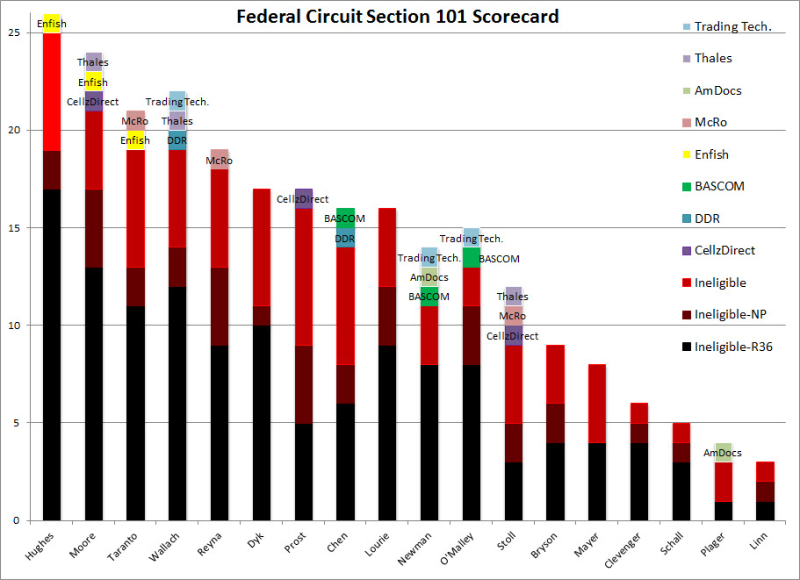
This chart shows the number and type of Section 101 decisions by member of the Federal Circuit since Alice. Red indicates issued, precedential opinions finding ineligible subject matter; dark red indicates non-precedential opinions, and black are per curiam affirmances. The remaining colors are opinions finding eligible subject matter, color coded as shown on the right. Judge Lynn Hughes leads the field with 26 decisions, and only a single finding of eligible subject matter in Enfish. Judges Timothy Dyk, Alan Lourie, William Bryson, Haldane Robert Mayer, Raymond Clevenger, Alvin Schall and Richard Linn have yet to find a patent eligible (though not for want of trying, as both Lourie and Linn argued in concurrences in Ariosa that the claims were eligible but felt bound by Mayo to hold otherwise). Judge Kara Stoll, the newest member of the court, leads in finding eligible subject matter, with 25% of her decision (and a bonus kicker for a dissent in Intellectual Ventures v. Symantec arguing that one of the patents was eligible).
One of the questions that comes up frequently is how do the current trends compare to the pre-Alice days? The next figure provides that comparison:

Here, I look at the 32 months before and after Alice (i.e., up to Feb. 2017). The differences are pretty stark. Prior to Alice, there were only 37 district court decisions on Section 101, and 359 afterwards, nearly a 10-fold increase; similar increases in the number of patents challenged and invalidated. The rate of invalidity jumped as well, from 43.2% pre-Alice to 61.8% currently.
As I have noted before, it is software, not business method patents that have been the target of the post-Alice changes; communication patents now occupy the second most heavily targeted group:
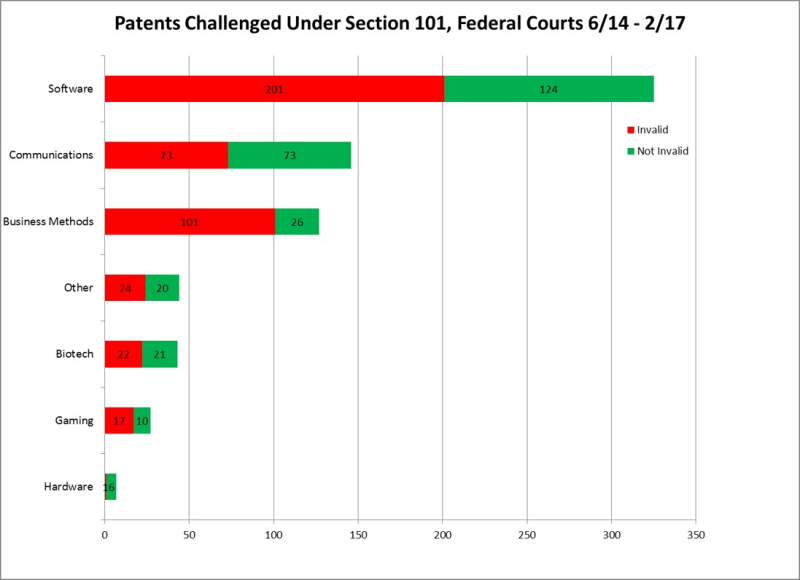
Let’s now turn to the USPTO.
Using data collected from Patent Advisor, I have been tracking Section 101 rejection rates (non-final and final rejections) and well as allowances. My database includes every office action mailed in 2014-2016. I’ve aggregated the office actions into periods, based on their mailing date. Each date range corresponds to a particular “guidance” period for the examiner guidance memos issued by the USPTO:
|
Period
|
Start Date
|
End Date
|
|
Before Alice
|
|
6/19/14
|
|
Preliminary Guidance
|
6/20/14
|
12/14/14
|
|
Interim Guidance
|
12/15/14
|
7/31/15
|
|
July Update 2015
|
7/31/15
|
5/5/16
|
|
Enfish May 2016
|
5/6/16
|
11/2/16
|
|
McRo Nov. 2016
|
11/3/16
|
12/31/16
|
I use the guidance periods because we would expect to see changes in examiner behavior, if any, between periods, as the USPTO further refines and clarifies how the examiners are to issue Section 101 rejections. For most art units, we have seen a drop in the Section 101 rejection rates following an overall peak in the Interim Guidance period. That said, there’s been little drop in rejection rates.

In particular, I was interested to see if the McRo memo issued in November 2016 has had any impact. McRo was a well-reasoned decision that should have made it easier to obtain allowances in software related applications. From the numbers it is too early to make this assessment. On the one hand, we’re not seeing a clear decline in Section 101 rejection rates post McRo. On the other hand, there’s been a slight uptick in the notice of the allowance rate (note the last column below):
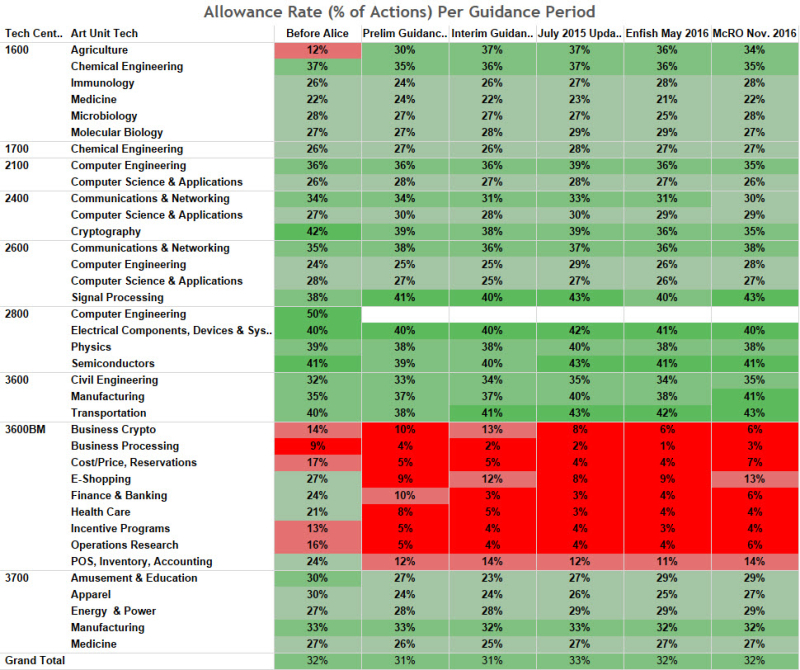
The most significant post-McRO change occurred in the E-shopping art unit, with a 4% increase in the allowance rate from 9% to 13%. I’ll continue to monitor the impact of the McRO memo over time. The USPTO may issue additional guidance memos or examples based on a recent Federal Circuit decision, Thales Visionix, Inc. v. United States, which reversed a lower court decision finding a patent on mechanisms for determining the position of a moving object (e.g. the helmet of a fighter pilot) relative to a moving reference platform (e.g., the plane), so we may continue to see improvement in the rejection and allowance rates.
We also continue to see that the Business Method art units (TC 3600BM) reject applications at higher rates than other art units, for the same classifications of inventions:
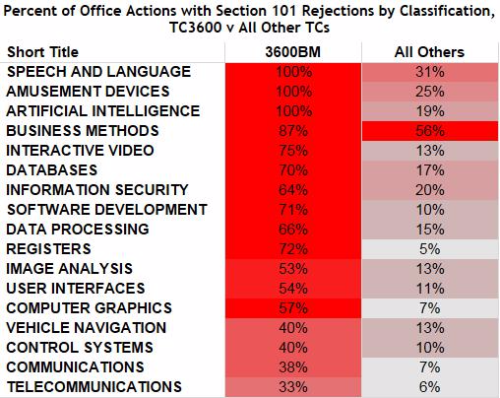
Even in highly "technical" fields like software development or computer graphics, examiners in TC 3600BM reject applications are substantially higher rates than their peers in other art units.
One factor that I find quite telling is the rate of Office Actions that have Section 101 rejections without any prior art rejections. This is perhaps the most frustrating of circumstances for patent prosecutors, especially for final rejections. In this table, I’ve limited the time period to the post-Enfish period (office actions mailed after May 5, 2016) and I’ve compared the rate of Section 101-only rejections with the rate of prior art only rejections (rejections with either Section 102 or 103 rejections and no Section 101 rejections):
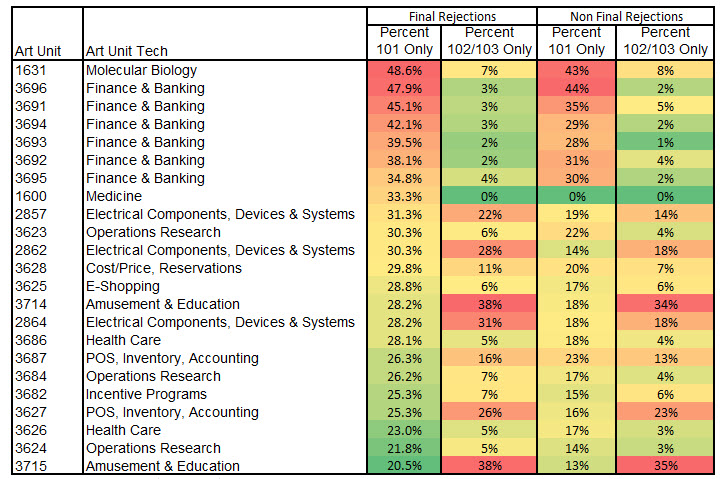
What surprised me here was that the highest rates of Section 101-only rejections were in Art Unit 1631, Microbiology. Not surprisingly, the business method art units are right behind, but they also they have the lowest rate of prior art rejections. How can it be then that these applications are so “routine and conventional” as to support a Section 101 Rejection?
Art units 2857 and 2862 are also unexpected here. It would seem that by nature, most applications in Electrical Component and Devices would be patent eligible subject matter, and whatever defects may appear in the claims originally and rejected in a first office action should be typically cured by amendment.
Another question that comes up is whether applications filed after Alice are rejected under Section 101 more frequently than those filed before. Here’s the data:
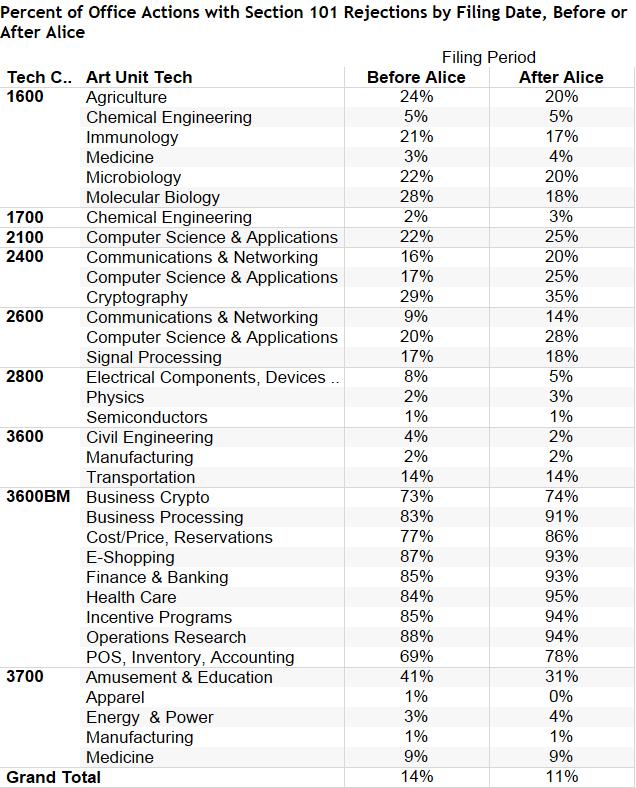
As shown here, post-Alice filed applications do better in Tech Center 1600, but appreciably worse in TCS 2400, 2600 and of course 3600BM.
One place that has seen an interesting development is in ex parte appeals on Section 101. Here are the total numbers and rates of affirmances of Section 101 rejections by PTAB between December 14, 2015 and February 28, 2017:

Overall, the PTAB tends to sustain examiners on Section 101 rejections. But the total numbers hide an interesting development:
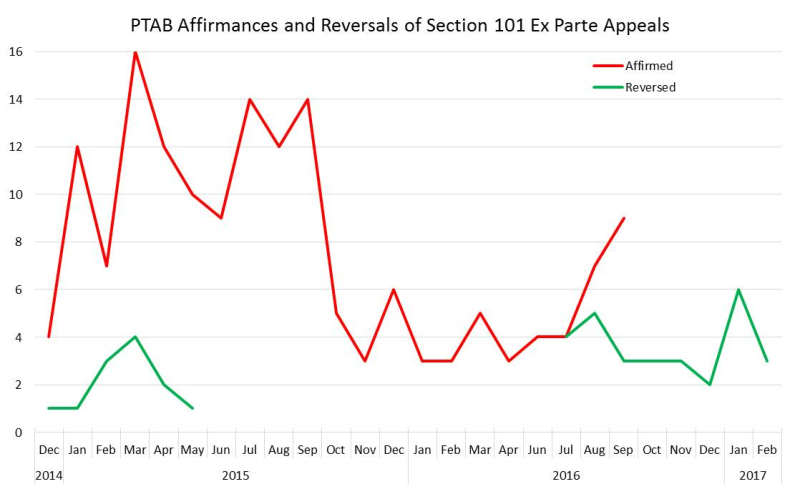
Here we see that recently, the PTAB reversed 16 Section 101 rejections in a row beginning in October, 2016—and 14 of these were from the Business Method art units. This is perhaps the best news I’ve seen in months, a bit of sunshine in the land of the dark.